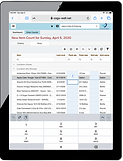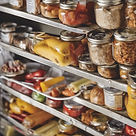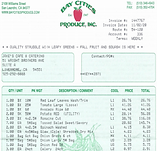
There is a core set of features that a restaurant operator should look for in any inventory, recipe, and cost management system. Before purchasing a system, it is best to know what features and integrations should be standard in a comprehensive system.
Inventory Management
A restaurant inventory management system should include features for importing invoices, exporting to your accounting system, and counting, ordering, receiving, and transferring inventory items.

Counts: An inventory management system must also include the ability to count and value your inventory on hand. Ideally, the counts can be taken on a mobile device or via a worksheet. Count valuations should include the option to use the last case cost or the weighted average cost for items.

Ordering: Ideally, the ordering features will include order entry, order templates, par levels, and suggested reorder levels. Ordering should also include an option to order by vendor or order by item. The system should generate purchase orders that can be automatically emailed or exported to vendors.
Invoice Processing: An inventory management system should include a solution for scanning and importing invoices to automatically update the inventory item receiving database, The summary invoice information should export to your Accounts Payable system. Paper invoices should not need to be entered manually. A quality inventory system can also import invoices directly from vendors with EDI capability.

Receiving/Invoice Detail: Inventory items, pack size, quantity received, and pack cost for each item should be tracked. Invoices should be viewable with an invoice image should be included. There should be a variety of receiving reports such as receiving by item, by vendor, and detail versus summary versions.
Transfers: If your restaurants transfer between locations or utilize a commissary, an inventory system must include features for requesting and fulfilling transfers. The transfer feature should adjust costs, stock levels, and export cost adjustments to your general ledger system. Watch out for systems that only include transfer fulfillment, but do not include making transfer requests as requests are a key feature.

Actual Usage: An inventory management system should calculate your inventory usage at an item level as well as an aggregated level that is in line with how you track your cost of goods sold (COGS). The accounting formula for this is: Beginning inventory, + purchases, +/- transfers, – ending inventory = Actual Usage and COGS.
Accounting Integration: Your inventory system should be interfaced with your accounting system to export invoice information to accounts payable, export transfer adjustments, and export ending inventory valuation adjustments to your general ledger.
Recipe Management:
A quality inventory system will also include recipe costing and modeling features. These features allow you to add the ingredients for each of your recipe items and calculate the cost to prepare each recipe item based on the most recent ingredient costs. The ingredient costs should always be up to date (reflect the last invoice).
Multiple Recipe Unit Types: Onions might be used by the weighted ounce in one recipe, by the cup in another, and by each in another recipe item. The best recipe systems can handle one ingredient with recipe units for more than one measure class (volume, weight, and count).

Scalable Recipe Units: You might use a tablespoon of vinegar in one recipe, a cup in another, and a liter in another recipe. The best recipe costing systems allow you to easily select from multiple recipe units within the same measure class.

Preparation Instructions: A recipe management system should also include the option to enter preparation instructions including pictures, steps, descriptions, and preparation utensils.
Recipe Modeling: Ideally, a recipe for a sales item (a menu item you sell) can be modeled against a target cost percentage to determine what price the item should sell for to achieve the target. You should also be able to model different pricing to see the resultant cost percentage.
Prep and Production: Many recipe management systems include “prep or production” features that enable you to track items you prepare in a batch (like a 5-gallon batch of chili). The best systems can also suggest how much to prep or produce. Be sure the system provides the capability to count recipe items that you prepare and the best systems allow you to track theoretical usage for a prepared item or its ingredients.
Waste: A quality inventory system will also provide the option to track and report waste. It should accommodate tracking waste for inventory and recipe items.
Food and Beverage Cost Analysis:

An inventory, recipe, and cost management system must interface with your Point of Sale system to import the menu item sales mix (what menu items were sold, at what price, and in what quantity). The best systems integrate with numerous POS systems and can rapidly integrate with new ones.
Theoretical Cost & Usage: Theoretical cost and usage are calculated by combining the sales mix with the recipe for each menu item to determine what your cost of sales and inventory usage should be (your theoretical cost and usage).
Variance Analysis: The system should compare theoretical cost and usage to your actual cost and usage to determine variances to help isolate problems such as theft, over-portioning, or too much waste.

Menu Analytics:
An inventory system that includes recipes and a POS interface should also provide you with an analysis of your menu performance (menu engineering). What menu items are not in line with your targets and what menu items are your most (or least) profitable?
Menu Engineering: A key component of Menu Analytics is a "Menu Engineering" report. This report looks at menu item profitability and popularity to inform you about which menu items are contributing the most profit (stars) or which ones are not contributing (dogs).

Multi-Restaurant:

Even if you only have one restaurant location, having the flexibility in your system to address multiple locations should be included in your inventory system.
If you do have multiple locations, then sharing common vendors, inventory, and recipe items, is essential. It is also important to be able to isolate unique items.
A quality inventory system will allow you to both isolate and compare your locations. This enables managers to only see and focus on their location, while the home office team can evaluate all locations.
Inventory management systems that are designed for multi-unit operators should have the ability to add franchisees to a company database, isolate them from the company locations, and handle integrations to different POS and/or accounting systems.
Summary:
We have reviewed the six primary components to look for in a comprehensive inventory and recipe management system:
Inventory Control
Invoice Processing
Recipe Management
Food & Beverage Cost Analysis
Menu Analytics
Multiple Locations
A summary of the essential features of an Inventory and Recipe Management system is provided below:



Comments